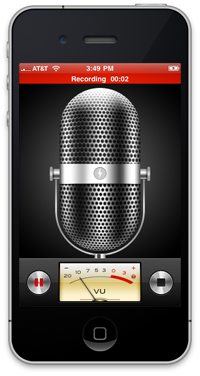
Every journalist has found herself in some version of this situation: Bianca Vazquez Toness, a reporter for Boston’s WBUR public radio, drove about 40 minutes north of her office Tuesday to interview the controversial mayor of Lawrence, Mass. Only when she arrived did she realize she had forgotten her audio kit — recorder, microphone, cables, headphones, everything. Gah.
What she had brought with her, though, was her iPhone. She had no choice but to try using that to record or risk losing a big interview.
When I heard the piece that turned out on WBUR’s air the next morning, I had no idea — nor would I have believed — that a cellphone had captured the sound coming through my radio. Sure, I knew a phone could record sound, but not broadcast-quality sound.
Toness (a friend and former colleague) had ended up using a $30 app called Report-IT Live, which includes advanced tools for live broadcasting and phone interviews. Any software, including Apple’s free Voice Memos app, works just as well, however. To maximize the sound quality, she advised, don’t use the crummy mike built into the phone’s Apple-supplied earbuds, just the phone itself, and hold it close (very, very close) to the person talking.
During her interviews Tuesday, Toness was a professional using, essentially, amateur equipment. But it’s not hard to imagine an amateur journalist using the same equipment in the same way. The web turned everyone into writers; inexpensive SLRs and point-and-shoot digicams turned everyone into photographers. The smartphone “could be the technology that turns everyone into a radio reporter,” Toness told me. “All my colleagues now — they heard it, and they’re like, ‘Why do we carry these huge kits around?'”
Public radio people can be pretty snobby about audio quality — I can say that, having worked in public radio for five years — but, given the alternatives proliferating in the market, it’s getting harder to justify the expense and bulk of pro kits for field work. Judge the audio quality of Toness’ piece for yourself. And remember, as you close your eyes and turn up the volume in your noise-canceling headphones, that most listeners hear radio stories over a cheap FM set while making breakfast, getting the kids dressed, or driving to work. News producers may be snobby about sound quality, but consumers, generally, are anything but.
Toness is by no means the first reporter to experiment with smartphone-based reporting. A year ago, WTOP reporter Neal Augenstein packed away all of his equipment — laptop, recorder, cameras, and all — to become “the first major-market radio reporter to do all his field reporting on an iPhone.” Augenstein recently reported on his iPhone-only experience for PBS MediaShift (an account, for all you nerds, that’s chock full of equipment details):
A year in, iPhone-only reporting isn’t perfect. While audio editing works great, with the phone’s built-in microphone I’d estimate the sound quality of my field reports is 92% as good as when I use bulky broadcast equipment. Getting better audio for my video is a real challenge. And if I ever have to cover a story from a subway tunnel or location where there’s no WiFi or cell coverage, I won’t be able to file until I resurface.
MediaBistro’s 10,000 Words recently published its own guide to the art of iPhone reporting. There are some good tips — switch on Airplane Mode to avoid interruptions, buy an adapter to plug in a real microphone — but the best advice is this: “Look like a legit journalist.”
Jerome Hubbard, a UC Berkeley journalism student, took the legitimacy question to the street — using his iPhone to record the video, of course. Can a reporter armed only with a smartphone be taken seriously? Hubbard’s unscientific finding was “yes.”
Said one man on the street:
I would take you seriously, Jerome, because you approached me very professionally. You’re very polite, you’re very kind. You asked my permission. You look like the journalist type. And you’re using modern technology.
So maybe professionalism is derived from old-fashioned manners, not the gear you’re slinging. (What’s that saying, the best camera is the one that’s with you?) And, besides, freedom from bulky gadgets may actually make for a better interview. All that equipment can be a hindrance, especially among sources who aren’t used to being sources.
“I actually feel like people were less intimidated or distracted by it,” Toness said of her makeshift recording kit. “Also, I don’t look quite as conspicuous on the street, which I like.”
There is an intriguing possibility that the entire production process can be executed on the road. At WBUR, reporters typically bring their sound back to professional engineers, who mix finished pieces. Even that can be done on a phone now. A $10 app called Monle is a four-track, non-linear audio editor for iPhone. And as Josh noted last month, the iPad can also be an all-in-one field kit with Apple’s GarageBand. That $5 app includes a fast, dead-simple, eight-track editor. A reporter in the field could conceivably record her interviews and voice tracks, mix a piece and send it back home, shoot photos and video, and, perhaps with the aid of a Bluetooth keyboard, type and file a script — all on one device that weighs less than two pounds.
Toness used her personal phone for the interview, an iPhone 4, since WBUR supplies its employees with BlackBerry devices. And now that they’ve heard her Lawrence story, she says, her co-workers are a little envious. “My colleagues said, ‘OK, when are we getting iPhones?'”